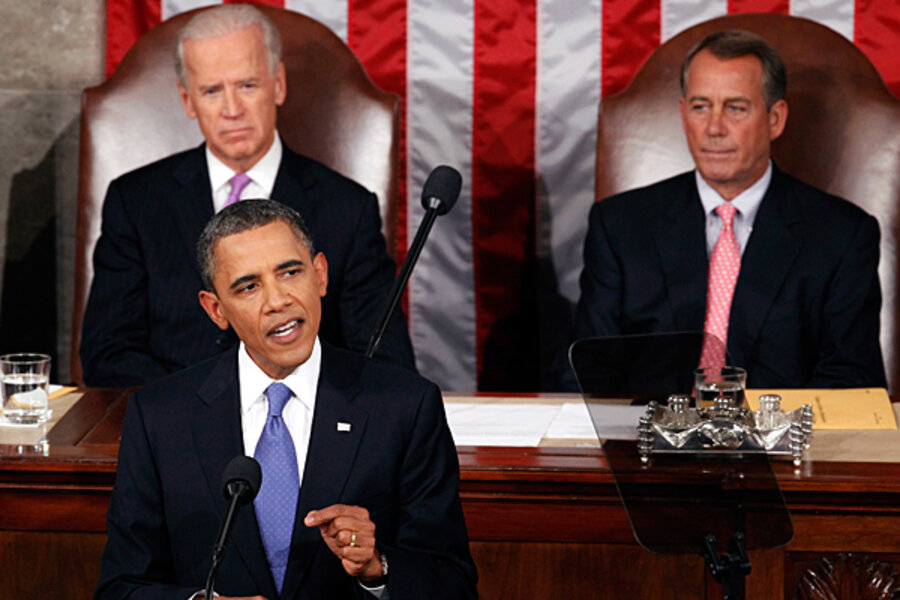Obama speech: Will his jobs plan work?
Loading...
| Washington
President Obama on Thursday outlined a $447 billion package of tax cuts and new federal spending that he said would jolt the economy back into life and provide millions of new US jobs.
The centerpiece of the package is a proposed extension and expansion of the current reduction in the payroll tax that employees and employers pay to help fund Social Security. This tax cut would cost about $240 billion, according to White House estimates.
The package also offers $35 billion in aid to states intended to prevent teacher layoffs, as well as $25 billion in new funds to help with school construction.
It would allocate about $70 billion to general infrastructure projects such as roads and bridges. Some $10 billion of this would create a so-called “infrastructure bank,” a sort of revolving fund that could pay for infrastructure efforts over time.
Mr. Obama’s package also includes a proposed extension of expanded unemployment benefits, aid for mortgage refinancing, and other smaller, miscellaneous projects.
What’s the expert reaction so far to the Obama speech so far? Do economists and politicians think his plan will work – and can it pass Congress?
Mark Zandi, chief economist of Moody’s Analytics in West Chester, Pa., said he believes that if enacted as a package, Obama’s plan would add 1.9 million jobs, cutting the unemployment rate by a percentage point from its current 9.1 percent level. It would boost US gross domestic product by two percentage points, he said in an analysis of the package.
“The plan would go a long way toward stabilizing confidence, forestalling another recession, and jump-starting a self-sustaining economic expansion,” concluded Mr. Zandi.
However, Zandi adds, Obama’s assertion that the plan is fully paid for depends upon the deficit-cutting actions of Congress in the future and is thus highly uncertain. Furthermore, it would result in weaker growth in 2013, as the effects of the package fade.
“Presumably the economy will be strong enough to handle it by then, but that is far from certain,” Zandi said.
Patrick Knudsen, a fellow in budgetary affairs at the Heritage Foundation, which is in Washington, countered that the package was simply a rerun of ideas from Obama’s previous flops.
“What President Obama calls a ‘jobs plan’ is really just stimulus redux: a typical Keynesian-style set of infrastructure, school construction, teacher pay, unemployment benefits, and temporary tax breaks that have demonstrably failed in the two-and-a-half years since the $825-billion Recovery Act,” Mr. Knudsen wrote in his own analysis.
That criticism was echoed by American Enterprise Institute scholar Andrew Biggs, a former deputy commissioner of Social Security.
“If we hadn’t heard this speech before – and passed a trillion dollar stimulus based on it – I think people might be more open to it. But right now it’s ‘been there, spent that,’ ” Mr. Biggs wrote in a blog post on the president’s speech.
Obama’s plan is sort of an omnibus effort of various job-creation theories, pointed out policy blogger Ezra Klein in The Washington Post. If you like tax cuts, it’s got tax cuts aimed at sparking hiring. If you like bridge projects, it’s got infrastructure bucks. If you think education is key, it contains support for teachers.
“So the question for Congress ends up being simple: Do you want to focus on the things you do like and compromise on the things you don’t like in order to get some action on jobs and deficit reduction?” Mr. Klein wrote on his Wonkbook blog.
The reaction of the congressional Republican leadership to the plan has been noncommittal. House majority leader Eric Cantor, at a lunch Thursday sponsored by the Monitor, indicated that he hoped the White House and the GOP could work together on items in the plan they all support. Speaker John Boehner echoed this point of view following Obama’s address, saying the proposals “merit consideration.”
Some rank-and-file Republicans were more dismissive.
“Tonight’s speech makes it clear that the White House continues to favor rhetoric over results when it comes to addressing the nation’s many challenges,” Rep. Tom Price (R) of Georgia, chairman of the conservative House Republican Policy Committee, said in a statement.
In general, the plan’s political fate may depend on how it becomes defined in the political arena. Many of its individual features are popular and have commanded bipartisan support in the past. But the words “stimulus” and “spending” are unpopular, notes New York Times polling expert Nate Silver.
That means the White House is likely to talk about the pieces of the plan, while opponents may talk about it in terms of its general characteristics.
“We’re likely to see a real semantic scrum over the next few weeks as partisans seek to define the territory that the bill occupies,” Mr. Silver writes on his FiveThirtyEight blog.
Obama’s political calculation may be that Republicans as well as the administration are smarting from the public’s disapproval of the recent debt-ceiling standoff.
By proposing things that seem nonthreatening and even bipartisan, he’s hoping to get Republicans to acquiesce to at least the things they’ve supported in the past, writes William Galston, Brookings Institution senior fellow in governance studies.
“If they don’t, he will be positioned to argue that Republicans are putting party above country, working to defeat him for re-election even at the cost of further slowing the economy and possibly tipping it into a second recession,” writes Mr. Galston in his own online analysis.





